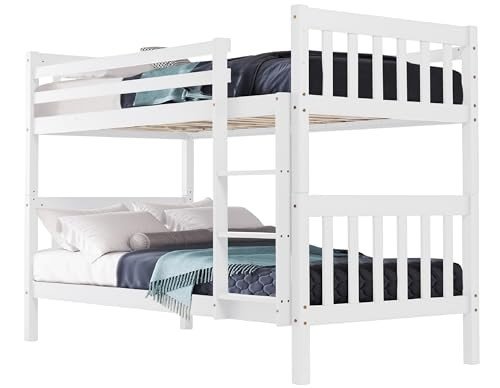Exploring Bunk Beds: A Comprehensive Guide
Bunk beds have long been a staple in children's bed rooms, dorms, and even homes with restricted space. Not just do they offer a useful sleeping service, but they also develop a fun and creative environment for children and a great space-saver for adults and families. Adult Bunk Beds melwaycott.top will explore everything you require to know about bunk beds, from types and materials to security pointers and buying suggestions.
Tabulation
- Kinds Of Bunk Beds
- Traditional Bunk Beds
- Loft Beds
- Triple Bunk Beds
- L-Shaped Bunk Beds
- Material Options
- Wood
- Metal
- Security Considerations
- Purchasing Guide
- FAQs
Kinds Of Bunk Beds
Bunk beds can be found in various styles to fit various needs and preferences. Here's a breakdown of the most common types:
Conventional Bunk Beds
Standard bunks typically feature 2 beds stacked vertically on top of one another. These beds are ideal for siblings sharing a space or for taking full advantage of sleeping space in visitor rooms.
Loft Beds
Loft beds stand likewise to conventional bunk beds but do not have a lower sleeping location. Rather, they frequently include a desk or seating area beneath, making them a great choice for little rooms needing multifunctionality.
Triple Bunk Beds
Triple bunk beds are created for three residents, with beds stacked in a three-tier setup. These are less common however can be an enjoyable service for big families or sleepovers.
L-Shaped Bunk Beds
With one bed positioned horizontally and the other vertically, L-shaped bunk beds are typically geared up with extra functions such as desks or storage drawers and can match corner areas in a room.
Comparison of Bunk Bed Types
| Bed Type | Perfect Use | Description |
|---|---|---|
| Conventional | Shared bed rooms or guest spaces | Two beds stacked vertically |
| Loft | Little rooms requiring multi-purpose space | Upper bed with open space beneath |
| Triple | Large families or slumber parties | Three beds stacked vertically |
| L-Shaped | Corner or versatile areas | A combination of vertical and horizontal beds |
Product Options
Bunk beds are manufactured from numerous products, with wood and metal being the most typical. Each product has its pros and cons.
Wood
- Toughness: Generally robust and can stand up to years of usage.
- Visual Appeal: Offers a timeless look that can mix with different decorations.
- Weight Capacity: Typically tougher; can support much heavier weights.
- Drawbacks: May be more pricey than metal choices and can be prone to scratches.
Metal
- Durability: Generally light-weight and easy to move however still durable.
- Modern Design: Often comes in smooth designs, making it appealing for modern spaces.
- Affordable: Usually less costly than wood choices.
- Downsides: Can be cold to the touch in winters and may not have the very same visual appeal for some purchasers.
Safety Considerations
When it concerns bunk beds, safety can not be neglected. Here are key safety pointers to bear in mind:
- Guardrails: Ensure that the top bunk has guardrails on both sides to avoid falls.
- Durable Construction: Check for a strong develop and strong materials to withstand weight and movement.
- Weight Limit: Adhere to the maker's weight limit for both the upper and lower bunks.
- Ladder Design: Choose bunks with a safe, easy-to-climb ladder and avoid any sharp edges or rungs.
- Age Restrictions: Most makers advise that kids under the age of 6 should not oversleep the upper bunk.
Purchasing Guide
When shopping for bunk beds, consider the list below factors to find the very best fit for your requirements:
- Space Availability: Measure the space size and ceiling height, guaranteeing there is appropriate space for the leading bunk.
- Bed Size: Decide between twin, full, or larger sizes based on your needs and the size of the room.
- Style Preference: Consider the overall decor of the bed room to find an ideal style.
- Alleviate of Setup: Look for a bunk bed that is straightforward to assemble.
- Budget plan: Bunk beds are available in various cost ranges, so figure out a spending plan before starting your search.
Frequently asked questions
1. What is the suggested age for children to sleep on the leading bunk?
Children aged 6 and older are normally recommended to sleep on the top bunk to decrease the danger of falls.
2. How can I make my bunk bed safer?
To improve security, ensure guardrails are correctly set up and inspect that the bed is placed on a flat surface. In addition, encourage kids to utilize the ladder thoroughly.
3. Can I convert a bunk bed into two separate beds?
Numerous bunk beds are created to be convertible. Inspect the manufacturer's specs for convertibility features.
4. What devices are offered for bunk beds?
Common accessories consist of bed linens, storage drawers, staircases rather of ladders, and tented canopies for an enjoyable visual appeal.
5. How do I preserve my bunk bed?
Regular checks for loose screws or structural stability can help make sure safety. Dust the bed frequently and tidy spills immediately to keep the materials in good condition.
Bunk beds are flexible and a space-efficient service for various living circumstances, from kids's rooms to guest lodgings. With lots of styles and products available, prospective purchasers have a wealth of alternatives to think about, making sure a combination of functionality and looks. By prioritizing safety and following the suggestions laid out in this guide, people can discover the best bunk bed that matches their space and lifestyle, all while producing a pleasurable sleeping environment.

